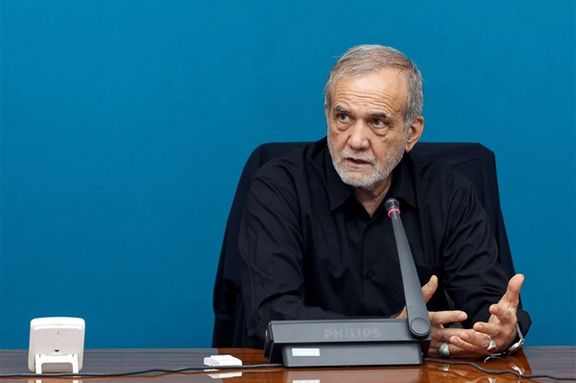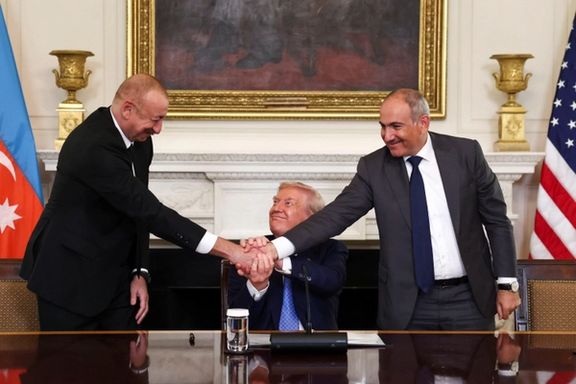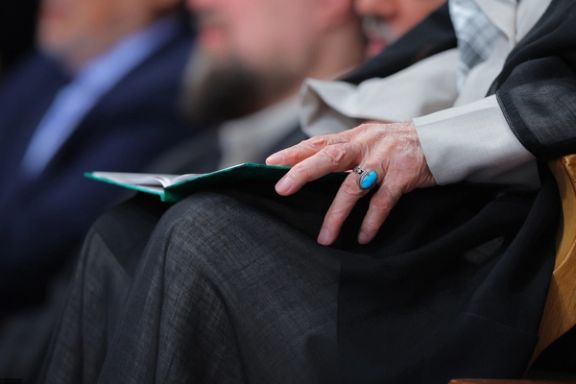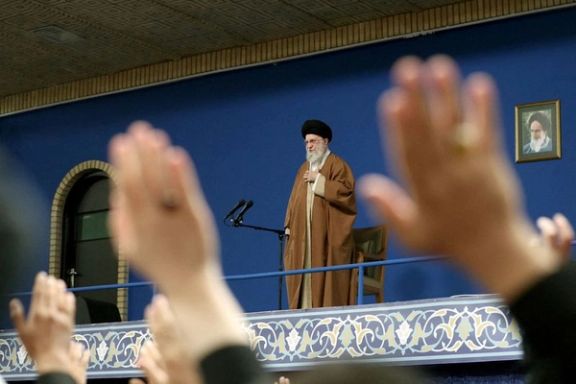Iran says US directed Israel’s strikes in June 12-day war

Iran’s president said on Saturday that Israel’s attack on the country during the June 12-day war was carried out under US direction and in pursuit of Washington’s objectives.

Iran’s president said on Saturday that Israel’s attack on the country during the June 12-day war was carried out under US direction and in pursuit of Washington’s objectives.
“The Zionist regime, with the guidance and support of America, attacked Iran, and this attack was in line with America’s objectives,” President Masoud Pezeshkian said in remarks broadcast on state TV. He said the aim was to create chaos through “blind strikes” and the assassination of military commanders, scientists and civilians.
Twelve-day war
Iran and Israel fought a 12-day conflict in June that included US strikes on Iranian nuclear facilities at Isfahan, Natanz and Fordow, and Israeli strikes that destroyed critical infrastructure, killing several senior military and scientific figures as well as hundreds of civilians. Iran responded with missile strikes that killed at least 27 Israeli civilians.
Pezeshkian said the attackers aimed to spread unrest but failed. “The people, with their presence on the scene and their resistance, were victorious,” he said, adding that even prisoners and political opponents joined in defending the country. “When it comes to the security and independence of the country, all differences fade and the principle is Iran.”
Trump’s comments on Iran
President Donald Trump on Wednesday described Iran as “a very evil place” and credited US action with preventing wars across the Middle East by crippling Tehran’s nuclear program. “We have stopped wars in the Middle East by stopping Iran from having a nuclear weapon,” he said. “They can say they’re going to start all over again. But that’s a very dangerous thing for them to do, because we’ll be back as soon as they start.”

Iran cautioned on Saturday that any foreign interference near its borders could undermine security in the South Caucasus after Armenia and Azerbaijan signed a US-brokered peace agreement.
“We express our concern about the negative consequences of any foreign intervention, especially in the vicinity of our shared borders, that could harm the region’s lasting security and stability,” the foreign ministry said in a statement.
It said Iran “welcomes the finalization of the peace text by the two countries” as “an important step in achieving lasting peace in the region,” but added that projects near its borders should be developed “within the framework of mutual interests, with respect for national sovereignty and territorial integrity, and without foreign interference.”
Agreement signed in Washington
The announcement came a day after Armenian Prime Minister Nikol Pashinyan and Azerbaijani President Ilham Aliyev signed the agreement at the White House with US President Donald Trump. The agreement includes exclusive US development rights to a strategic transit corridor through the South Caucasus that the White House said would facilitate greater exports of energy and other resources.
That route will connect Azerbaijan and its autonomous Nakhchivan exclave, which are separated by a 32-kilometer-wide (20-mile-wide) patch of Armenian territory. The deal includes an agreement that will create a major transit corridor to be named the Trump Route for International Peace and Prosperity, the White House said.
Armenia and Azerbaijan have long been in conflict over territory and fought several wars. Russia acted as the main mediator for years, but its influence has declined since its 2022 invasion of Ukraine.
Tehran calls for regional framework
The ministry said Iran is ready to continue “constructive cooperation” with Armenia and Azerbaijan through bilateral and regional channels, including the 3+3 mechanism, which brings together Armenia, Azerbaijan and Georgia with Iran, Russia and Turkey to address regional issues without outside powers.

The Oct. 7 Hamas attack on Israel was the result of years of planning by Iran, Mohsen Mahdian, managing editor of the state-run Hamshahri daily, said on Friday in remarks published on Supreme Leader Ali Khamenei’s official website.
Mahdian tied the June 12-day war between Iran and Israel to what he called the same long-term strategy that led to Oct. 7. “The first point is that the war should not be analyzed as a single moment,” he said in an interview that was part of a package titled the Narrative of Victory. “This war was the result of a strategic plan in the field. We had built this over the years.”
He said Israel’s strikes in June were not a show of strength but a move Iran had expected. “You pushed him [Israel] into the corner of the ring, and he has no choice but to attack,” Mahdian said. “He does this not from power, but from desperation. This is a passive move against a long-term program that you have created.”
Since the Oct. 7 Hamas attack in 2023, Israel has degraded Iran’s regional influence. That campaign crippled much of the so-called “Axis of Resistance,” including Hamas, Hezbollah, and armed groups in Syria and Iraq, and has reduced the capacity of these groups to operate.
Four days after the Hamas assault, Khamenei insisted Iran had no role. “It was the work of the Palestinians,” he said, adding: “We defend Palestine. We kiss the foreheads and arms of the young, wise and intelligent Palestinian planners, but this was their own work.”
Iran’s stance on Israel’s elimination
Mahdian said it was “both true and not true” that Iran seeks Israel’s elimination. He said Khamenei and the late Ruhollah Khomeini have both called for the removal of what they term the “Zionist regime,” but not through direct Iranian military action.
The idea, he said, is that others should take the lead. “The people should rise and decide to remove this regime,” Mahdian said. “We will definitely support this.”
He described this as a consistent policy in which Iran backs what it sees as oppressed populations against what it calls oppressors, while not carrying out such operations itself. “In this sense, we seek the removal of the Zionist regime, not in the sense of entering ourselves,” he said.

The Committee to Protect Journalists (CPJ) on Friday condemned threats by the Islamic Republic against the families of journalists working for Iran International, BBC Persian and Radio Farda, calling the tactic “emotional hostage-taking”
“Families of journalists working for outlets like BBC Persian, Iran International & Radio Farda are harassed, summoned, and threatened simply because their loved ones report from abroad,” CPJ posted on X, urging Iran to “end these transnational tactics of intimidation.”
Iran International filed an urgent appeal with United Nations experts on August 4, urging them to take action against Iran over serious risks to the lives and safety of their journalists worldwide and relatives inside Iran.
“Over the past weeks, the Iranian authorities have intimidated and threatened 45 journalists and 315 of their family members with death unless they stop working for Iran International by specific deadlines,” Iran International said in a statement.
All of those deadlines given by Iran's Ministry of Intelligence and Security have now passed, it added.
Since its formation in 2017, Iran International journalists have been targeted by the Iranian authorities for their reporting. This has included threats of assassination, assault and abduction against staff based in Britain, the United States and Europe.
Iran continues to be ranked among the world’s worst countries for press freedom.
According to Reporters Without Borders, “Iran has reinforced its position as one of the most repressive countries in terms of press freedom, with journalists and independent media constantly persecuted through arbitrary arrests and harsh sentences handed down after unfair trials before revolutionary courts.”

The United States on Friday called the reappointment of veteran powerbroker Ali Larijani to lead Iran's Supreme National Security Council a step back to failed strategies, saying the Iranian people deserve forward-looking leadership.
"The appointment of Ali Larijani as Secretary of the Supreme National Security Council by the Iranian regime reflects its continued reliance on the same old figures and outdated strategies," the State Department said in a post on its Persian X account.
Earlier this week, Larijani was reappointed to a role from which he resigned two decades ago after clashes with ultra-hardline President Mahmoud Ahmadinejad.
"Larijani’s return to a role he held nearly two decades ago signals the leadership’s preference for failed solutions over forward-looking approaches," the State Department said.
"The people of Iran deserve a model of governance that embraces accountability, progress, and innovative ideas."
For much of his career, Larijani was known as a staunch conservative.
He vocally opposed reformist President Mohammad Khatami and the broader reform movement, using his position as head of the state broadcaster IRIB to discredit Iranian intellectuals.
Yet by 2015, Larijani emerged as a key supporter of the Iran nuclear deal, helping secure its approval in parliament in under 20 minutes despite conservative opposition. The move aligned him with then-president Hassan Rouhani and marked a dramatic pivot from his earlier hardline stance.
Khamenei publicly praised Larijani at the time as a "problem-solver," though his growing closeness to Rouhani reportedly raised eyebrows in the Supreme Leader’s inner circle.
Despite being sidelined in recent presidential elections—disqualified by the Guardian Council in both 2021 and 2024 allegedly over his daughter studying abroad—Larijani has evidently regained the trust of Iran's theocrat.
Following President Ebrahim Raisi’s death last year, he was handed two sensitive tasks: overseeing the Iran-China strategic accord and acting as an intermediary with Russia after Israeli strikes on Iranian soil.
While many establishment figures kept a low profile during the crisis, Larijani reemerged as a visible supporter of the Islamic Republic and its top leadership.

Iran’s revamp of a top national security body signals a ruling system in decline, former US State Department official Len Khodorkovsky told Eye for Iran, calling it “pure theater” and likening it to “rearranging deck chairs on the Titanic.”
“We’re seeing the leadership desperate and flailing away in various ways to try and preserve its control and its hold on power,” he said. “Whether you stand up the defense council, whether you change the name of the currency ... the ship is still sinking.”
Khodorkovsky served as Deputy Assistant Secretary of State during the first Trump administration, working closely with the Special Representative for Iran on the administration’s “maximum pressure” campaign.
Born in the Soviet Union, he emigrated to the United States as a child after experiencing life under the communist system. From abroad, he watched the country of his birth unravel — a collapse that, he says, offers lessons for Iran today.
His prediction rests on a convergence of forces the leadership cannot reverse: an economy in freefall, a public that has lost faith in the system, and leaders resorting to cosmetic moves to mask deep structural decay.
Drawing on the lessons of the Soviet collapse, he argued that once cracks appear in an authoritarian system, its fall can come faster than expected.
Iranian officials framing: “Wartime necessity”
Iranian state media has portrayed the council — approved August 3 by the Supreme National Security Council (SNSC) under Article 176 of the constitution — as a crucial wartime measure.
Chaired by the president, it includes the heads of the judiciary and parliament, senior military commanders, key ministers, and two representatives of Supreme Leader Ali Khamenei.
Veteran lawmaker Alaeddin Boroujerdi called it “necessary given the current wartime situation,” saying it would allow military and defense decisions to be made “in a concentrated manner” during critical moments. Esmaeil Kowsari, a former Revolutionary Guards commander, said it would speed the chain of command and “with timely strikes, suppress threats.”
The revival of such a body — last active during the 1980–88 Iran–Iraq War — follows a 12-day war with Israel in June, during which Iranian military and nuclear facilities were hit by Israeli and US strikes.
Larijani’s return: rebrand, not reboot
Two days after the council’s creation, President Masoud Pezeshkian appointed Ali Larijani as SNSC secretary.
Khamenei quickly followed, naming Larijani his personal representative to the body. A political veteran, Larijani previously served as SNSC secretary from 2005 to 2007, was speaker of parliament for over a decade, and has long been an adviser to the Supreme Leader.
Khodorkovsky said Larijani’s appointment will not change the system’s trajectory. “They’re trying to look strong externally, but internally the system is rotting,” he said. “The personnel changes are cosmetic — the fundamentals are the same.”
Mounting internal strain
Iran’s ruling system is buckling under severe economic pressure. The rial has collapsed—dropping from around 300,000 per USD in 2020 to over 1 million in early 2025—losing more than 80 percent of its value. Inflation remains among the highest in the world.
A nationwide truckers’ strike began on May 22, 2025, in Bandar Abbas, a key southern port city on the Persian Gulf, spreading within days to more than 155 cities across all 31 provinces by June 1.
The strike brought key transport routes to a halt and drew public sympathy as a flashpoint of economic and social discontent.
Since the June war with Israel, Iran has seen no major uprisings — only scattered strikes and protests amid a heavy security presence.
Authorities have intensified arrests of activists, expanded surveillance, and deployed security forces in restive provinces to deter gatherings.
Against this backdrop, the truckers’ strike has been the most visible form of unrest, reflecting deep and widespread grievances across the population.
For Khodorkovsky, these are the real forces eroding the state’s foundations — and they cannot be reversed by councils or reshuffles.
“You can change the faces, you can change the names, you can create new institutions,” he said, “but when the people have turned away and the economy has collapsed, the end is only a matter of time.”
You can watch the full episode of Eye for Iran on YouTube or listen on any major podcast platform like Spotify, Apple, Amazon, or Castbox.